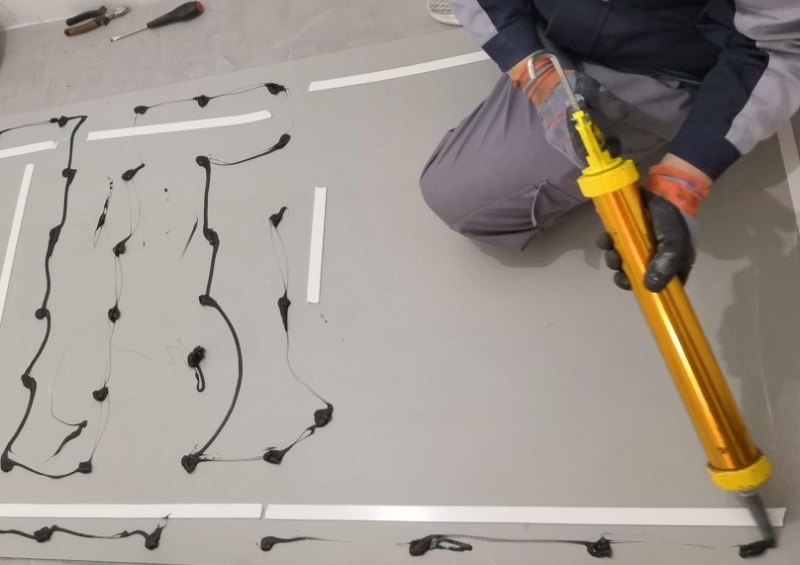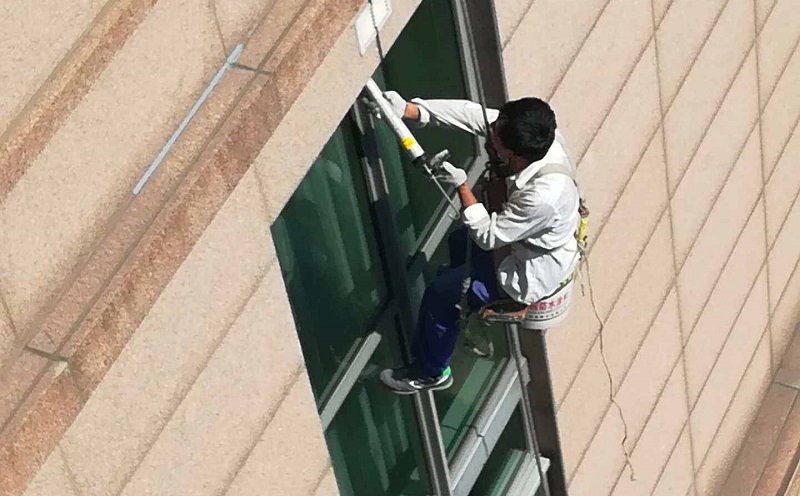MS glue is an abbreviation for modified silicone, also known as silane modified polyether glue in Chinese. It is a type of prepolymer with large molecule polyether bonds as the main chain and hydrolyzable siloxane groups capped
& nbsp; & nbsp; Prefabricated building sealant MS adhesive usage encyclopedia knowledge
& nbsp; & nbsp; Seam design
& nbsp; & nbsp; According to the magnitude of its displacement, joints are divided into displacement joints and non displacement joints. For displacement joints, an appropriate joint width can ensure the displacement of the MS adhesive and ensure that the MS adhesive is fully filled. Three sided bonding of the joint should be avoided to ensure the displacement ability of the MS adhesive; For non displacement joints, an appropriate joint width can ensure sufficient filling of MS adhesive. This type of joint can be constructed with three sided bonding due to the absence of displacement requirements.

& nbsp; & nbsp; Due to the thermal expansion and contraction characteristics of materials, the actual width of the joint is currently affected by the performance of MS adhesive and the use of the substrate. According to requirements, it is recommended that the width of the joint be no less than 6mm, and there is also a maximum joint width. Currently, the construction width is about 40-50mm. If the width exceeds 50mm, the sealant manufacturer (Ruilangda Company) should be consulted according to the project situation to determine; Depth is half the width. If the depth is too large, when the joint deformation increases and the MS adhesive is displaced, the surface is prone to unevenness, resulting in excessive pressure deformation and bonding failure; If the depth of the joint is small and the amount of adhesive is insufficient, it may cause cracking due to stress concentration or the formation of bubbles, and even lead to bonding failure. Therefore, it is generally recommended that the depth of MS adhesive should not exceed 12mm and the width should not be less than 6mm. (Layout of water guide pipes: Water guide pipes should be installed every 2-3 layers at the cross joint of prefabricated exterior wall panels for water treatment. When the vertical joint is separated below, water guide pipes should be installed at the partition. The water guide pipes should be compatible with the sealant and have good bonding performance.)
& nbsp; & nbsp; Seam treatment
& nbsp; & nbsp; Ensure that the construction surface is clean and dry. The joint surface requires no defects, protrusions, or residual concrete. It can be initially treated with a wire brush or angle grinder, and then cleaned of impurities and floating dust at the joint with compressed air (hair dryer) or soft bristled brush. The surface of the processed substrate should be dry, clean, dense, and have a uniform texture.

& nbsp; & nbsp; Place backing material
& nbsp; & nbsp; In order to ensure the displacement capacity of MS glue and prevent three side bonding at the joint, foam strips shall be used to fill the joint. It is recommended to use open cell polyurethane foam rod, closed cell polyethylene and other materials as filling materials. The width of foam rod shall be about 25% wider than the crack, and the width w shall be generally controlled within the range of 10mm to 35mm. The thickness of MS glue shall be 1/2 of the crack width and not less than 6mm. When the width w≤ When 10mm, d is generally taken as w; If the width w>; When 10mm, d=1/2w can be taken, and the depth range is generally taken as 6mm≤ d≤ 12mm or 1/2w≤ d≤ w,, The width w and depth d need to be measured with a ruler< br />
& nbsp; & nbsp; Paste masking tape
& nbsp; & nbsp; To prevent contamination of the surrounding concrete surface of the joint and enhance the aesthetics of the building during construction, it is necessary to apply masking tape to the joint before applying MS adhesive. The tape should be adhered to the 45 degree chamfered edge of the joint, but should not enter too much into the joint, otherwise it will be inconvenient to remove the masking tape after applying MS adhesive. Meiwen paper should be removed promptly after applying MS glue< br />
& nbsp; & nbsp; Apply primer
& nbsp; & nbsp; In order to ensure the adhesion of the joint, it is necessary to fully brush the primer on both sides of the joint and on the foam strip with a small brush, and evenly brush the surface to ensure that the bonding surface is wet. Tighten the bottle cap immediately after using the primer, and do not pour the remaining primer back into the original container< br />
& nbsp; & nbsp; MS adhesive filling
& nbsp; & nbsp; After the primer is fully dried (about 0Cut the nozzle into 45 degrees depending on the specific environment;, When extruding MS glue, it should be evenly and continuously squeezed out from the glue nozzle, and the movement speed along the joint should be slow and uniform to ensure that the joint is filled with glue. When“ Ten” Word interface or“ T” When injecting glue into the interface, a sufficient amount of sealant should be filled at the interface before pulling the glue in other directions< br />
& nbsp; & nbsp; Seam surface decoration
& nbsp; & nbsp; After the glue injection is completed, in order to ensure the compactness of the glue injection in the joint, a scraper is used to press and smooth the joint surface in the opposite direction of the glue injection, and then the joint surface is decorated to ensure its aesthetics. The width of the scraper can be customized according to the width of the joint, ensuring the construction quality and efficiency of the joint< br />
& nbsp; & nbsp; Remove the decorative paper
& nbsp; & nbsp; The decorative paper should be removed after the surface treatment of the joint is completed. When cleaning, attention should be paid not to touch the surface of the adhesive joint. After completion, the joint should ensure no significant displacement within 48 hours, otherwise it will affect the sealing effect.
nine hundred and two
& nbsp; & nbsp; Storage safety
& nbsp; & nbsp; (1) MS glue should be stored in a cool and dry place at room temperature, with a storage temperature not exceeding 27 ℃ and not lower than 5 ℃, and a shelf life of 12 months< br />
& nbsp; & nbsp; (2) The shelf life of the original sealed primer is 12 months, and unused primer cannot be returned to the original packaging< br />
& nbsp; & nbsp; (3) Not suitable for bonding with materials such as polypropylene (PP), polyethylene (PE), polytetrafluoroethylene (PTFE), etc< br />
& nbsp; & nbsp; (4) The construction temperature range is 4 ℃~40 ℃, and construction should not be carried out at other temperatures< br />
& nbsp; & nbsp; (5) Not suitable for long-term use in humid environments< br />
& nbsp; & nbsp; (6) When bonding, it is necessary to ensure the cleanliness of the bonding surface< br />

